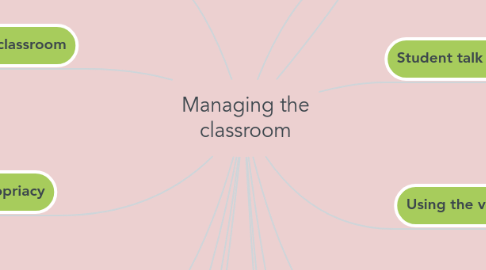Managing the classroom
by Vanessa Rivas

1. -Classroom management -The teacher in the classroom -Proximity -Appropriacy -Movement -Awareness -Using the voice -Audibility -Variety -Conservation -Talking to students -Giving instructions -Student talk and teacher talk.
2. The teacher in the classroom
2.1. This includes promoting learning and supplementing activities, coordinating and collaborating with support staff, using a variety of teaching approaches, and adapting instruction to include all students
3. Proximity in the classroom
3.1. It is refers to standing in close proximity to any student that causes, or is about to cause, a class disruption. This could mean anything from standing close to a talkative student to walking around the room while students work in groups to make sure they are on task and not disrupting others.
4. Appropriacy
4.1. so is the general way in wich teachers sit or stand in classrooms. many teachers create an extremaly friendly atmosphere by crouching down when they work with students in pairs.
5. Awaraness
5.1. in order to manage a class succesfully, the teacher has to be aware of what students are doing and, where possible, how they are feeling. this means watching and listening just as carefully as teaching.
6. Conservation
6.1. it is important that they breathe correctly so that they dont strain their larynxes. breathing properly means beign relaxed and using the lower abdomen to help expand the rib cage,thus filling the lungs with air.
7. Giving instructions
7.1. the best activity in the world is a waste of time if the students dont understand what it is they are supposed to do. there are twogeneral rules for giving instructions: they must be kept as simple as possible, and they must be logical.
8. movement
8.1. some teachers, tend to spend most of their class time in one place at the front of the class, others spend a great deal of time walking from side to side, or striding up and down the aisles between the chairs.
9. Classroom management
9.1. refers to the wide variety of skills and techniques that teachers use to keep students organized, orderly, focused, attentive, on task, and academically productive during a class.
10. Student talk and teacher talk
10.1. Overuse of teacher talking time is inappropriate because the more a teacher talks, the less chance there is for the students to practice their own speaking- and it is the students who need to practice, not the teacher. If a teacher talks and talks, the students will have less time for other things, too, such as reading and writing.
11. Using the voice
11.1. Our most important instrument as teachers is our voice. How we speak and what our voice sounds like have a crucial impact on classes. When considering the use of the voice in the management of teaching, there are three issues to think about: audibility, variety and conservation. Clearly, teachers need to be audible.
12. Audibility
12.1. clearly, teachers need to be audible,they must be sure that the students at the back of the class can hear them just as well as those at the front. good voice projection is more important than volume.
13. Variety
13.1. the kind of voice we use to give instructions or introduce a new activity will be different from the voice which is most appropiate for conversation or an informal exchange of views or information. however, for teachers who almost never raise their voices, the ocassional shouted interjection may have an extremely dramatic effect, and this can sometimes be beneficial
14. Talking to students
14.1. the manner in wich they interact with them is one of the crucial teacher skills, but it does not demand technical expertise. though the teacher students relationship is not the same as that between a parent and child,
15. What information do they need first? which should come next?
15.1. when teachers given instructions,it is important for them to check that the students have understood what they are beigb ask to do.


